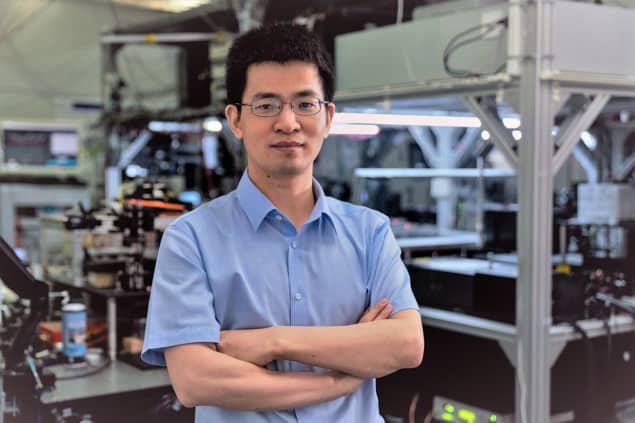Chaoyang Lu from the University of Science and Technology of China in Hefei talks to Michael Banks about planning Quantum 2020 – a major online conference – and the future of quantum technologies

What first sparked your interest in quantum physics?
I had an interest in physics at high school and just before the Chinese New Year in 1998, our school invited Jian-Wei Pan to give a public science lecture that was held in the largest cinema in Dongyang in Zhejiang province. At the time Pan was in Anton Zeilinger’s group at Innsbruck University in Austria and they had just reported their first quantum-teleportation experiments. The lecture was intriguing but to some extent it all sounded a little crazy.
But it was fascinating enough for you to study physics?
Yes. I then studied physics at the University of Science and Technology of China (USTC) in Hefei and joined Pan’s group where I worked on a number of interesting problems such as six-photon entanglement, quantum simulation of anyons and teleportation of quantum-logic gates. In 2008 I moved to the University of Cambridge in the UK to do a PhD before moving back to USTC in 2011.
What are you currently working on?
In the past few years, I have focused on the development of scalable quantum-light sources for “boson sampling” – an intermediate quantum-computing model. My current research covers a variety of topics from blue-sky research to emerging quantum technologies such as large-scale quantum entanglement, quantum teleportation and quantum computing. I am still young enough to start exploring new fields such as atom arrays in optical tweezers and superconducting circuits.
In 2015, you and colleagues were awarded the Physics World Breakthrough of the Year for your work teleporting two quantum properties of a photon. How has research moved on since then?
We have made steady progress, for example, making quantum teleportation more “complete” by carrying out the first experimental demonstration of “high-dimensional” teleportation of a quantum spin-1 system (Phys. Rev. Lett. 123 070505). My colleagues have also achieved teleportation over longer distances by exploiting the Micius satellite. This has allowed us to go from about 100 km to 1400 km via a ground station to space (Nature 549 70). We have also proposed and demonstrated a teleportation-inspired method to efficiently simulate random quantum circuits that redefine the limits of “quantum advantage” (Phys. Rev. Lett. 124 080502).
How has COVID-19 affected your work and are you now starting to reopen the labs?
Students had already returned home for the Chinese New Year when the COVID-19 outbreak emerged. During the height of the pandemic, people showed a remarkable ability to come together. Thanks to the selfless dedication of medical workers and the strong measures taken by the Chinese government, COVID-19 was effectively controlled within a short time. Graduate students have returned to campus cautiously in a step-by-step and organized way. As far as I know, not a single student or faculty member of USTC was affected by the COVID-19 virus.
As chair of the Quantum 2020 conference in October, what do you hope it will achieve?
Quantum 2020 aims to bring together the international quantum-science community to learn, share and collaborate on the latest research and emerging areas of interest. Taking place over four days from 19 to 22 October, it is co-organized by the USTC, the Chinese Physical Society (CPS), the UK’s Institute of Physics and IOP Publishing, which publishes Physics World.
The virtual event gathers early-career and established researchers from universities, industry and governments worldwide. Beyond a high-profile programme of more than 30 invited talks from world-leading figures in the field, Quantum 2020 will also feature two special interactive panel sessions covering industry and worldwide initiatives in quantum technology.
The meeting is now virtual given the COVID-19 pandemic. How has the organization gone?
We began to organize the Quantum 2020 event at the end of last year. The original plan was to hold the conference at USTC’s Shanghai campus. But because of the COVID-19 situation, in March I suggested changing it to a virtual conference. Organizing an online meeting has been a new experience, but it has gone well thanks to the help of the advisory committee and the quantum-science community. The virtual format delivers several benefits in terms of time and efficiency and we have seen a real appetite from invited speakers and panellists to get involved. We are very excited by the calibre and diversity of the scientific programme.
Have there been any benefits of it going online?
I believe that virtual conferences will remain an important part of the scientific community beyond the current COVID-19 situation. We anticipate that the online format will have several benefits for participants including improved accessibility, reduced cost and personal disruption, as well as an overall reduction in carbon footprints from travel.
Are there any benefits of this conference to wider society?
In partnership with the CPS, we plan to translate some of the plenary and invited talks to raise the awareness of quantum physics and quantum technology in China. In addition, Quantum 2020 plans to establish new international awards to promote and encourage early-career researchers in quantum technologies. These will run alongside other high-profile awards in the field such as the Micius Quantum Prize awarded by the Micius Foundation, the biennial International Quantum Communication Award given out at the QCMC conference and the Rolf Landauer and Charles H Bennett award in quantum computing by the American Physical Society.
Quantum computing has accelerated recently. How do you see its development?
Scientists are gaining exquisite control at a fundamental level and pushing the physical boundaries. Such efforts will not only deepen our understanding of physics but also unlock unbelievable potential for new technology. In the not-too-distant future, they will become a reality to control and entangle thousands or even millions of quantum bits at will. Quantum simulators and computers will become first useful for physicists, chemists and engineers for applications of material and drug design. Many more surprises will emerge but, of course, they are hard to predict.
What excites you about the future of quantum technologies?
We are now beginning the second quantum revolution. Exploiting quantum superposition and entanglement offers a radical new way to transform our technologies from communication and computation to metrology. Comparing quantum computers with their classical counterparts is like comparing lasers to light bulbs. I believe that the development of quantum computers will follow a similar trajectory as lasers – first as a useful tool inside the laboratories then finding applications in many different areas. Inspired by what we know about the history of the laser, I believe what we have already discovered – for example, quantum key distribution, and quantum algorithms – is just the tip of the iceberg of what is to come.
With many countries pushing the implementation of quantum technologies, is is it driven more by co-operation or competition?
Quantum technology has a long way to go before it can be widely used. So, international co-operation and open exchanges are imperative. Just like how we all need to work closely together to confront the COVID-19 pandemic. Likewise, quantum technology is for all and not just a single country. The potential outcome from quantum research, such as solving energy problems, new materials, and new medicine, will too benefit all people. Diseases have no borders and neither should research.



